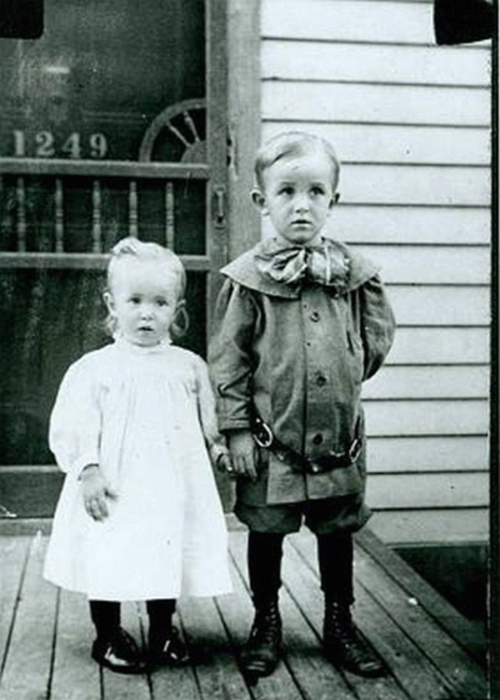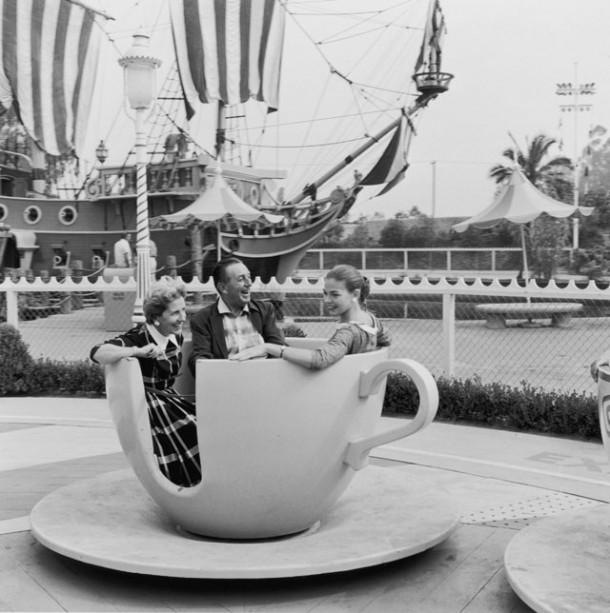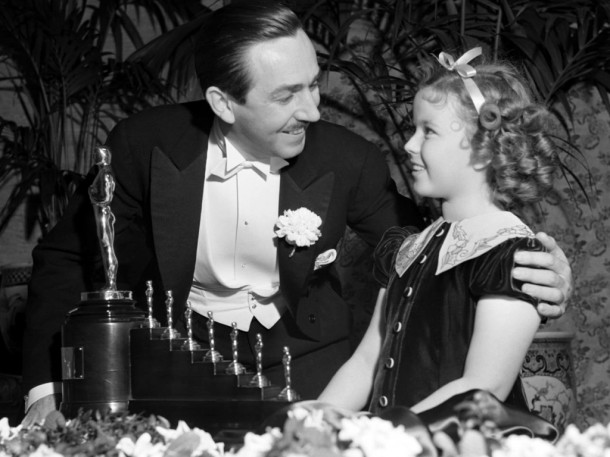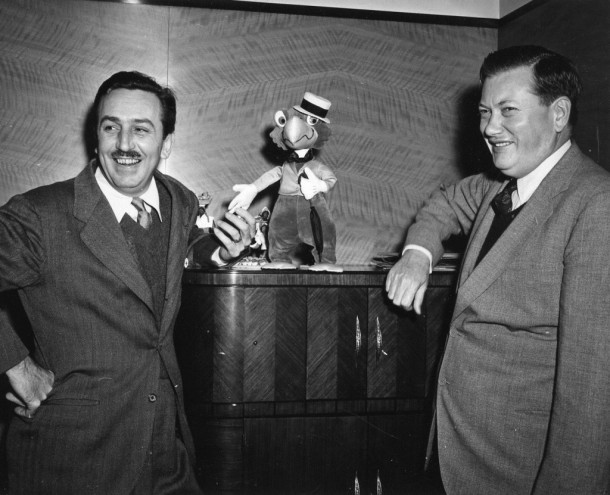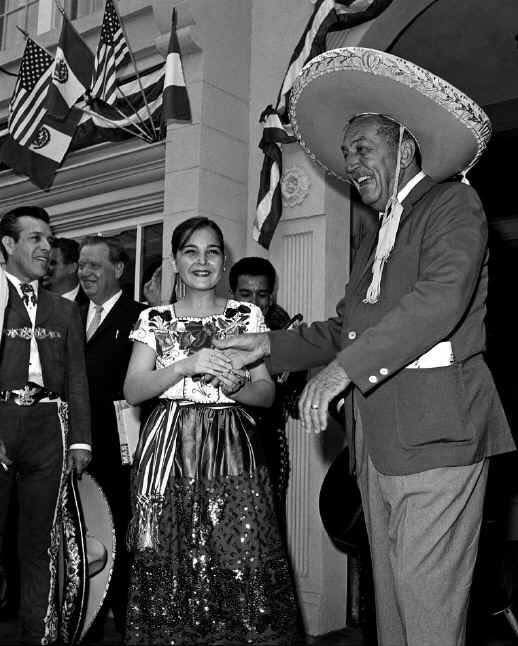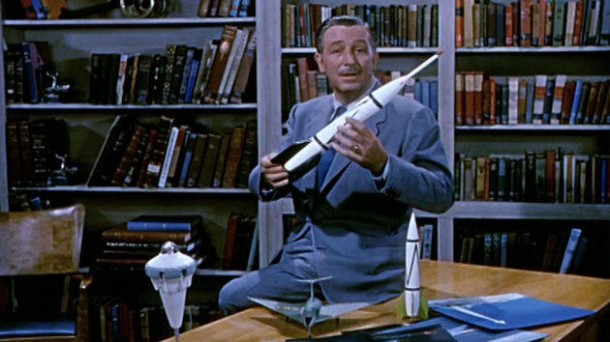TalkingHead
Well-Known Member
Here's an article from micechat that debunks a lot of the special on Walt, sorry if its already been posted.
Four hours to tell the story of Walt Disney… How do you capture 65 years of accomplishments and achievements and still properly tell the life story of the man behind the magic in such a short time frame? American Experience on PBS attempted to achieve this monumental task, showing the world that Walt Disney was neither sinner nor saint, but a human being. The program included first-hand accounts from people who worked for Walt or knew him personally. It also included many intellectuals and scholars who analyzed Walt’s thoughts or feelings with modern suppositions. I’d like to point out a few of these suppositions and unverified historical statements and debunk them with hard facts based on documentation, correspondence and memories of those who were there.
Walt and Ruth Disney on the porch of their birthplace in Chicago. The image was used out of context in the PBS biopic during a scene about Marceline, Mo. The address of the Chicago home was cropped out in the documentary.
WALT DISNEY – PART 1
1) “Walt Disney had a Dark Soul that he spent a lifetime fighting in an attempt to find the light.” This dramatic soundbite, while titillating, is unfortunately a forerunner of many statements made throughout the documentary that are either modern psychoanalysis of Walt Disney or supposition as to what he may have been thinking or feeling. There is no way to substantiate such a statement with facts and such an allegation can easily be refuted by those still living who personally knew Walt Disney, as a boss or as a family member. (Pure supposition by the histrionic Neil Gabler.)
2) The Walt vs. Elias relationship is played up as being negative throughout the documentary. It is unfair to say that Elias was a tyrant to have young Walt work to help his struggling family. It was very common at the turn of the century for children to work in support of their family and it’s not fair to compare Walt’s childhood to the typical baby boom childhood of the 1950′s or those of today. They further assert that Elias constantly fails and gives up where Walt always moves on. There is no historical record of Walt making a conscious decision at a young age that he was going to be the antithesis of his father. Here are Walt’s own words from a 1959 interview with the Los Angeles Herald Examiner newspaper on his supposed difficult childhood and tyrannical father: “Why are you so fascinated with childhood themes, fairy tales and a return to youth, when according to your biographers you had an unhappy childhood?” Walt answers sharply, “That’s just not true. Biographers always get things wrong. I had a wonderful childhood. Just because I had to work when I was a kid – up at 3:30a.m. on a paper route and all that – doesn’t mean I didn’t love it. My father was strict, sure. But he was having a hard time. He punished us when we got out of line and we deserved it.” (Supposition debunked by Walt Disney himself)
Walt and Lilly ride the brand new Tea Cups at Disneyland with daughter Sharon.
3) Walt and Lilly’s relationship is thankfully not represented as cold or loveless, but Lillian Disney is unfairly described as aloof and reserved as a mother and cool in her relationship with her daughters. That is not the loving mother that Diane Disney Miller shared personal memories of with me. (Supposition debunked by daughter, Diane Disney Miller)
4) While Walt is correctly shown as being a much more doting and domestic father than what was the norm of a man (especially the head of a studio!) in the 1930s/40s, he is represented as wanting to spoil his children to counter his relationship with his own father Elias. (Supposition, Not Fact!)
5) I have never come across any evidence of Walt Disney ever having conversations between himself and Mickey Mouse out loud. (Thanks for that schizophrenic thought Ron Suskind) Mickey may have been Walt’s alter ego, but they never conversed with each other, Walt just spoke his lines in cartoons. (Supposition, Not Fact!)
Walt Disney receives his special Oscar for Snow White and the Seven Dwarfs
6) Paraphrasing Carmenita Higgenbottom, “Walt felt slighted by the Motion Picture Academy for Snow White not being nominated as Best Picture. The special one-of-a-kind Oscar was nice, but he wanted to be taken seriously as a filmmaker who made art, not cartoons.” I have never come across any documented evidence of Walt sharing any feelings of being slighted or left out by his peers at the Motion Picture Academy. Snow White was celebrated as a monumental motion picture achievement and Walt Disney still holds the record for the most Oscar wins by a single person (32 Oscars!). (Supposition, Not Fact!)
7) Did Walt really wait until Roy was out of town to select the site of the Burbank Studio without consulting him? According to correspondence in the Disney Archives, Roy kept in contact with Walt and the Disney Studios chief legal counsel, Gunther Lessing, while he was away in Europe via telegram and mail. Lessing more than once mentions the fact that Walt is thinking about purchasing the land that would go on to become the Walt Disney Studio in Burbank. Land that Roy had previously seen according to Lessing’s letters. (Inaccurate based on correspondence at the Disney Archives.)
WALT DISNEY – PART 2
8) The program presents Walt “skipping town” during the studio strike to go to South America. The filmmakers omitted the fact that Walt’s true purpose for the South America trip was for a government sponsored goodwill tour that was in the works for months in advance. (See Ted Thomas’s excellent documentary “Walt and El Grupo” to learm more about this trip.) Walt didn’t leave the very tense and heated Studio environment just to vacation and escape his troubles as the documentary portrays it. That said, Walt’s absence definitely helped Gunther Lessing and Roy O. Disney settle the strike by essentially giving the union every concession they asked for. (Incorrect based on lack of proper historical context.)
Walt Disney and Ralph Peer with José Carioca from Saludos Amigos.
9) “Walt Disney did not cut his South America trip short to return for Elias Disney’s funeral.” Is this another slight towards his father? No. Walt Disney hated funerals. In Diane Disney Miller (and Pete Martin’s) 1957 biography of her father “The Story of Walt Disney”, Diane wrote “He never goes to funerals if he can help it. If he has to go to one, it plunges him into a reverie which lasts for hours after he is home. At such times he says, ‘When I’m dead I don’t want a funeral. I want people to remember me alive.’” Diane also recalled that when Walt’s older brother Herbert passed away in 1961, Walt kept an out-of-town appointment to avoid attending the funeral. The facts seem to show that Walt disliked funerals, no matter whose it may have been. (Incorrect based on lack of proper historical context.)
10) “Walt was distant and withdrawn from the production of the animated film Cinderella and left the “hard work” to his team.” Why would Walt Disney be so disengaged from the one project that the existence of his studio hinged upon? According to actress Lucille Bliss, who voiced stepsister Anastacia in the film, “Walt was so supportive… His Personal involvement in the project made us all try harder.” Walt would even attend the recording sessions of Cinderella’s voice actress, Ilene Woods. At one of these sessions Walt envisioned a multitude of soap bubbles that carried Cinderella’s reflection that would sing in harmony with her. Hardly a disengaged leader. (Supposition, Not Fact!)
11) “After the War Disney’s once cutting edge equipment was left rusting in a heap on the backlot.” Even though Cinderella would not be produced and released until 1950, the studio and it’s equipment did not lay dormant or unused after WWII. The Studio staff kept busy using the equipment to produce a series of “package features” from 1946 (Make Mine Music) to 1949 (The Adventures of Ichabod and Mr. Toad). (Incorrect based on lack of evidence and films that prove otherwise.)
Walt Disney at Disneyland’s Salute to Mexico in 1963
12) “Walt’s Films and TV shows excluded cultural diversity in the 1950’s and the 60’s and provided a narrow white, middle class view of American culture.” While Davey Crockett may have been Disney’s biggest TV star in the 1950’s, He also had many other diverse characters on his program like Elfego Baca and Don Diego de la Vega (better known as his alter ego, Zorro), His “People and Places” documentary series showcased diverse countries and cultures from “Sardinia” (1956) to “Samoa” (1956) to “Japan” (1960). Disneyland celebrated ethnic diversity from the start by inviting local cultural organizations to show their traditional costumes and dances in the Park’s first Christmas parade in December 1955. Themed cultural celebrations would continue for decades including a full fleged Salute to Mexico on Main Street USA in 1963. Walt was also an early member of President Dwight D. Eisenhower’s People to People International organization, whose mission is stated: “To enhance international understanding and friendship through educational, cultural, and humanitarian activities involving the exchange of ideas and experiences directly among peoples of different countries and diverse cultures.” The organization was even featured in a 1961 Episode of the Wonderful World of Color TV show. (Supposition, Not Fact!)
13) Carmenita Higgenbottom asked “Is It really him?”, Referring to the Walt Disney we saw in the intros to his television programs.”I don’t know. I want to believe it’s him. I hope it is. I think audiences want to believe its him”. According to Walt Disney’s grandson Christopher Miller, “The Walt Disney the world saw on television was the same Walt Disney we knew at home. Granddaughter Joanna Miller recalled that “sometimes we would kiss the TV when he would come on the screen because that was grandpa.” (Supposition debunked by Disney’s grandchildren.)
It is difficult to capture a life like Walt Disney’s in 4 Hours. That being said I wish a few important items had not been neglected:
CalArts: The City of EPCOT was not Walt’s only major project at the end of his life. In 1961 Walt Disney gave a generous endowment to form CalArts by merging the Los Angeles Conservatory of Music and Chouinard Art Institute. Walt envisioned CalArts as a community of the arts where students from every discipline could learn together in a synergistic way. Walt once said about Calarts, “It’s the Principle thing I hope to leave when I move on to greener pastures. If I can help provide a place to develop the talent of the future, I think I will have accomplished something.” Walt left 45 percent of his estate to CalArts.
The 1964/65 New York Worlds Fair: Much has been written about the impact of the Fair and its impact on Walt and it’s surprising that such a monumental event in Walt’s life was completely ignored. Walt was inspired to push creative and technological boundaries for his pavilions at the fair and created groundbreaking Audio Animatronic attractions like Great moments with Mr. Lincoln.
Disney Live Action Classics: Most of Walt’s live action films are ignored in this documentary. Classics like 20,000 Leagues Under the Sea, Old Yeller, and Swiss Family Robinson must have been left on the PBS cutting room floor.
Nearly 50 years after his passing, it’s amazing to think that so many people are still touched by the life and legacy of Walt Disney. It’s my hope that people will seek out the well written biographies and visit institutions like The Walt Disney Family Museum to get an accurate and factual understanding of who Walt Disney was. Disney Legend and Animator Floyd Norman summed up my feelings best when he said, “I’d like to think that this American Experience documentary would be like an icebreaker to having more people say let’s get to know this man better.” I’m happy to jump into that conversation anytime, what about you?
Some fans wouldn't be happy with anything less than a hagiography.

